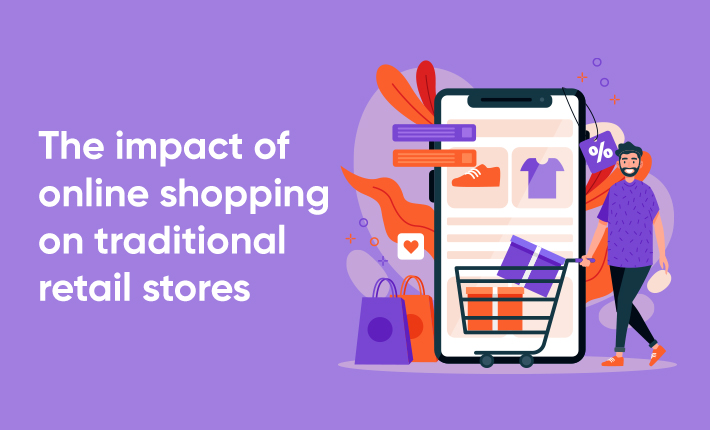Introduction to the growth of online shopping and its impact on traditional retail stores
In recent years, online shopping has experienced tremendous growth, and its impact on traditional retail stores has been significant. The ease and convenience of online grocery shopping have made it a preferred option for many consumers, and this has resulted in a decline in foot traffic in traditional brick-and-mortar stores. Retail stores that have been around for decades are now struggling to stay afloat in the face of the online shopping boom.
The rise of e-commerce giants like Amazon, Alibaba, and Walmart, among others, has disrupted the traditional retail landscape. These online retailers offer a wide range of products at competitive prices, and consumers can shop from the comfort of their homes. With the advent of smartphones and mobile devices, online shopping has become even more accessible, and consumers can shop on the go.
The impact of online shopping on traditional retail stores can be seen in the closure of many department stores and shopping malls. Retailers that have been slow to adopt online shopping have seen their sales decline, and many have been forced to close their doors. This has resulted in job losses and a decline in the overall health of the retail industry.
The growth of online shopping has also changed consumer behavior. Consumers now have access to a vast array of products from around the world, and they can easily compare prices and read reviews before making a purchase. This has made consumers more informed and discerning, and they are more likely to shop around for the best deals.
Over all, the growth of online shopping has had a significant impact on traditional retail stores. Retailers that have been slow to adopt online shopping have seen their sales decline, while those that have adapted have been able to thrive. The future of the retail industry will depend on how well traditional retail stores can adapt to the changing consumer behavior.
Comparison between online and offline shopping experiences for consumers
Online and offline shopping experiences offer vastly different experiences for consumers, and it's important to understand the differences to see why online shopping has become so popular in recent years.
One of the most significant differences between online and offline shopping experiences is convenience. Online shopping allows consumers to shop anytime, anywhere, and from any device. They can browse through thousands of products, compare prices, and read reviews from other customers, all from the comfort of their home or office. This convenience has made online shopping a preferred option for many consumers, especially those with busy lifestyles.
On the other hand, offline shopping requires consumers to physically visit a store. This can be time-consuming, especially if the store is far away or the consumer has to navigate through traffic or public transport. In-store shopping also has limited operating hours, which can be inconvenient for consumers who work long hours or have other commitments.
Another key difference between online and offline shopping experiences is the ability to touch and feel products before purchase. In-store shopping allows consumers to touch, feel, and try on products before making a purchase, which can be crucial for products like clothing or shoes. Online shopping, on the other hand, does not offer this option, and consumers have to rely on product descriptions, photos, and reviews to make a decision.
Online shopping also offers a wider range of products and brands than traditional retail stores. Consumers can shop from retailers all over the world, allowing them to access products that may not be available in their local stores. This has made it easier for consumers to find unique and specialty products that they may not find in-store.
Over all, while both online and offline shopping experiences offer their own unique advantages and disadvantages, the convenience and wider range of products available through online shopping have made it.
Analysis of the changing consumer behavior towards online shopping
Consumer behavior towards online shopping has changed significantly in recent years. Consumers have become increasingly comfortable with using digital technologies, and this has transformed the way they shop.
One of the most significant changes in consumer behavior is the way consumers research products before making a purchase. Consumers now use online resources to research products, read reviews, and compare prices before making a purchase. This has made them more informed and discerning, and they are more likely to shop around for the best deals.
Another change in consumer behavior is the shift towards mobile shopping. With the rise of smartphones and mobile devices, consumers are increasingly using mobile apps and mobile websites to shop online. This has made it easier for them to shop on the go, and has led to a rise in impulse purchases.
Social media has also played a major role in changing consumer behavior towards online shopping. Consumers now use social media platforms like Instagram, Facebook, and Pinterest to discover new products and brands. They can also interact with retailers and other consumers, which has made shopping a more social experience.
The rise of e-commerce platforms like Amazon, Alibaba, and eBay has also changed consumer behavior. These platforms offer a wide range of products at competitive prices, and consumers can shop from multiple retailers in one place. This has made it easier for consumers to find what they are looking for and has led to a rise in online marketplaces.
The COVID-19 pandemic has expedited the transition towards online shopping, as consumers increasingly turn to e-commerce platforms in response to social distancing measures and store closures. The pandemic has brought to light the convenience and safety of online shopping, leading to a surge in online sales and a significant impact on traditional retail stores. This has further emphasized the need for retailers to adapt and innovate to stay relevant in the changing retail landscape.
Discussion of the challenges faced by traditional retail stores in the era of online shopping
Traditional retail stores face a range of challenges in the era of online shopping. One of the biggest challenges is the decline in foot traffic in physical stores. With the rise of online shopping, consumers are increasingly shopping from the comfort of their homes, which has led to a decline in physical store visits.
Another challenge for traditional retail stores is the need to compete with online retailers on price. Online retailers often offer lower prices than traditional stores, which can make it difficult for brick-and-mortar retailers to compete. Traditional retailers may also struggle to match the wider range of products and brands that are available online.
Another challenge is the need to adapt to changing consumer behavior. Consumers are increasingly using online resources to research products before making a purchase, and they are more likely to shop around for the best deals. This means that traditional retailers need to find ways to engage with consumers online and offer a seamless shopping experience across multiple channels.
The COVID-19 pandemic has also highlighted the challenges faced by traditional retail stores. With social distancing measures in place, many consumers have been forced to shop online rather than in-store, which has accelerated the shift towards online shopping.
Finally, traditional retail stores need to find ways to differentiate themselves from online retailers. This could involve offering personalized customer service, creating a unique in-store experience, or focusing on niche products and services that are not available online.
Over all, traditional retail stores face a range of challenges in the era of online shopping. To compete, they need to find ways to adapt to changing consumer behavior, offer a seamless shopping experience.
Examination of the strategies adopted by traditional retail stores to compete with online shopping.
To compete with online shopping, traditional retail stores have adopted a range of strategies to attract customers and drive sales. Here are some of the most common strategies:
1. Improving the in-store experience: Brick-and-mortar retailers are focusing on creating a unique in-store experience to attract customers. This could include offering personalized customer service, creating an appealing store design, and incorporating technology like interactive displays and augmented reality.
2. Offering click-and-collect and curbside pickup: Many traditional retailers have adopted click-and-collect and curbside pickup options, allowing customers to purchase items online and pick them up in-store. This allows retailers to offer the convenience of online shopping while still driving foot traffic to physical stores.
3. Emphasizing the importance of local shopping: Traditional retailers are emphasizing the importance of supporting local businesses to attract customers. They are also partnering with other local businesses to create shopping events and promotions that drive foot traffic to stores.
4. Focusing on niche products and services: Brick-and-mortar retailers are focusing on offering niche products and services that are not available online. This could include offering unique in-store experiences, like cooking classes or workshops, or selling handmade or locally sourced products.
5. Integrating online and offline channels: Traditional retailers are integrating their online and offline channels to create a seamless shopping experience for customers. This could involve offering online reservations for in-store appointments or allowing customers to check availability and reserve items in-store.
6. Offering exclusive loyalty programs: Brick-and-mortar retailers are offering exclusive loyalty programs to customers, incentivizing them to shop in-store. This could include special discounts, early access to sales, or personalized offers based on their shopping history.
7. Providing faster shipping times: Traditional retailers are competing with online retailers on shipping times by offering faster doorstep delivery or even same-day doorstep delivery service options. This allows them to offer the convenience of online shopping while still competing on speed.
Over all, traditional retail stores are adopting a range of strategies to compete with online shopping. By improving the in-store experience, offering click-and-collect and curbside pickup, focusing on niche products and services, integrating online and offline channels, offering exclusive loyalty programs, and providing faster shipping times, they are finding ways to differentiate themselves and attract customers.
Case study analysis of successful traditional retail stores that have adapted to the rise of online shopping
Many traditional retail stores have successfully adapted to the rise of online shopping by adopting innovative strategies that have helped them retain customers and drive sales. Here are three case studies of successful traditional retail stores that have adapted to the era of online shopping:
1. Nordstrom: Nordstrom is a US-based department store chain that has successfully adapted to the rise of online shopping by offering a seamless shopping experience across multiple channels. In addition to its brick-and-mortar stores, Nordstrom has a strong online presence, with a well-designed website and a mobile app that allows customers to browse products, read reviews, and make purchases from their mobile devices. Nordstrom has also integrated its online and offline channels with features like buy online, pick up in-store and the ability to reserve items online and try them on in-store. By providing a personalized shopping experience and offering a range of convenient options for customers, Nordstrom has been able to compete with online retailers while still driving foot traffic to its physical stores.
2. Adidas: Adidas is a global sportswear brand that has adapted to the rise of online shopping by focusing on creating unique in-store experiences that cannot be replicated online. For example, the Adidas flagship store in New York City features interactive displays, a custom shoe bar, and a virtual reality experience that allow customers to design and personalize their own shoes. By creating immersive in-store experiences that focus on customer engagement and personalization, Adidas has been able to differentiate itself from online retailers and drive foot traffic to its physical stores.
3. Sephora: Sephora is a beauty retailer that has successfully adapted to the rise of online shopping by using technology to enhance the in-store experience. For example, Sephora has developed a mobile app that allows customers to scan product barcodes and access product information, reviews, and makeup tutorials. Sephora has also invested in digital signage and displays that showcase new products and provide customers with inspiration and ideas for makeup looks. By integrating technology into its physical stores, Sephora has been able to offer a unique and personalized shopping experience that cannot be replicated online.
4. Instant Genie: Instant Genie, a doorstep delivery services in Canada. With the rise of online grocery shopping in Canada, Instant Genie launched a doorstep delivery service to stay competitive. They partnered with local delivery services and created an online platform for customers to place orders. They also implemented a loyalty program to incentivize repeat purchases.
The success of their delivery service led to the expansion of their online offerings to include other household essentials, such as groceries, medicines, cleaning supplies and personal care products. They also integrated their offline and online channels by allowing customers to place orders online and pick up in-store.
In all these cases, the successful traditional retail stores have focused on delivering a seamless shopping experience across multiple channels, integrating online and offline channels, and providing personalized and unique in-store experiences. By understanding changing consumer behavior and adapting to the era of online shopping, these retailers have been able to stay competitive and drive growth in their physical stores.
Conclusion
In conclusion, online shopping has drastically transformed the retail industry, challenging traditional brick-and-mortar stores to adapt to new consumer behavior and preferences. While online shopping offers convenience and accessibility, traditional stores have to focus on creating a unique and personalized in-store experience to attract and retain customers. Successful retailers have embraced strategies such as omnichannel integration, experiential marketing, and innovative technologies to stay competitive. The future outlook for the relationship between online shopping and traditional retail stores remains dynamic, as retailers continue to adapt to changing consumer behavior and technological advancements. It is evident that the future of retail lies in the integration of online and offline channels to provide customers with seamless shopping experiences.







Post Comments